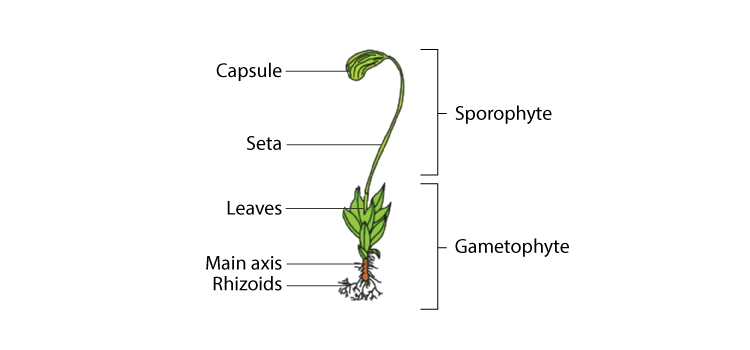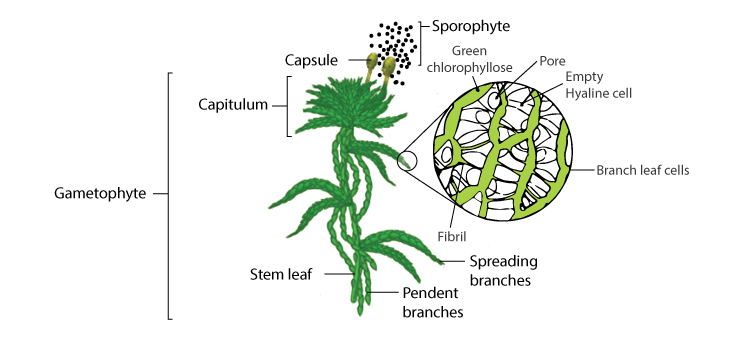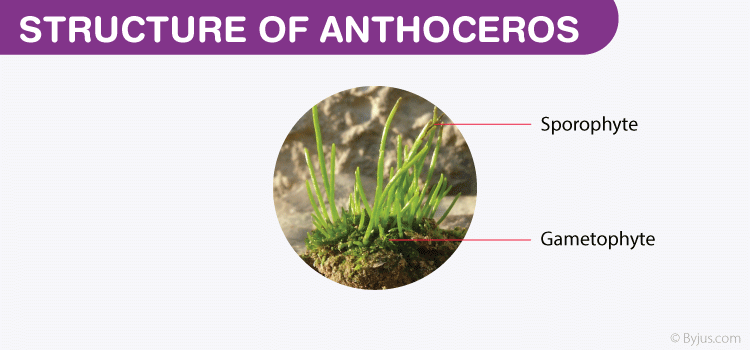Bryophytes
The term Bryophyta originates from the word ‘Bryon’ meaning mosses and ‘phyton’ meaning plants. Bryophyta includes embryophytes like mosses, hornworts, and liverworts. These are small plants that grow in shady and damp areas. They lack vascular tissues. They don’t produce flowers and seeds, instead, reproduce through spores. The study of bryophytes is called bryology.
Download Complete Chapter Notes of Plant Kingdom
Download Now
Table of Content
- Habitat Of Bryophytes
- Characteristics Of Bryophytes
- Classification Of Bryophytes
- Examples
- Ecological Importance
- Economic Importance
Why are bryophytes called amphibians of plants?
Bryophytes are called “amphibians of the plant kingdom” because they are terrestrial plants, but require water to complete their life cycle at the time of sexual reproduction.
Habitat of Bryophytes
Bryophytes thrive in a wide variety of habitats, range of elevations, temperatures and moisture. They can be seen growing in shady and damp environments, in extreme and diverse habitats such as arctic and deserts regions. It can grow where vascularized plants cannot as it does not depend on roots for the uptake of nutrients from the soil.
Some of the bryophytes remarkably tolerate lengthy periods of freezing and dry conditions and when moisture returns, the process of photosynthesis resumes. Several bryophytes thrive on persistent remains of its own growth or on soil and on decomposing or living matter of other plants. A few grow on bare surface of rock and some are aquatic in nature.
Their chief requirement to grow seems to be comparatively stable substratum to attach, a medium that retains moisture for long periods, appropriate temperature, enough sunlight, humid ambience would be lush for it to thrive.
Don’t miss: NEET 2022 Answer Key With Solutions
General Characteristics of Bryophytes:
- Plants occur in damp and shaded areas
- The plant body is thallus like, i.e. prostrate or erect
- It is attached to the substratum by rhizoids, which are unicellular or multicellular
- They lack true vegetative structure and have a root-like, stem-like and leaf-like structure
- Plants lack the vascular system (xylem, phloem)
- Bryophytes show alternation of generation between independent gametophyte with sex organs, which produces sperm and eggs and dependent sporophyte which contains spores
- The dominant part of the plant body is gametophyte which is haploid
- The thalloid gametophyte is differentiated into rhizoids, axis and leaves
- The gametophyte bears multicellular sex organs and is photosynthetic
- The antheridium produces antherozoids, which are biflagellated
- The shape of an archegonium is like a flask and produces one egg
- The antherozoids fuse with egg to form a zygote
- The zygote develops into a multicellular sporophyte
- The sporophyte is semi-parasitic and dependent on the gametophyte for its nutrition
- Cells of sporophyte undergo meiosis to form haploid gametes which form a gametophyte
- The juvenile gametophyte is known as protonema
- The sporophyte is differentiated into foot, seta and capsule
Characteristics Of Bryophytes

Classification Of Bryophytes
According to the latest classification, Bryophyta is divided into three classes:
- Hepaticopsida (Liverworts)
- Anthocerotopsida (Hornworts)
- Bryopsida (Mosses)
A. Hepaticopsida (Liverworts): The name hepaticopsida comes from the word “hepatic” meaning liver. Liverworts come under this class.
Hepaticopsida is further divided into 4 orders:
- Marchantiales (e.g. Riccia, Marchantia)
- Sphaerocarpales (e.g. Sphaerocarpos)
- Calobryales (e.g. Calobryum)
- Jungermanniales (e.g. Pellia)
The main characteristics of the class hepaticopsida are:
- Gametophyte plant is either thalloid or foliose
- In foliose forms, leaves are without midrib and dorsiventral
- Thalloid is dorsiventral, lobed and dichotomously branched
- Each cell of thallus contains many chloroplasts without pyrenoids
- Rhizoids are unicellular, branched and aseptate
- Sex organs are borne dorsally embedded in gametophytic tissues
- The sporophyte is made up of only capsule (in Riccia) or foot, seta and capsule (in Marchantia)
- The columella is absent in the capsule
- Sporogenous tissues develop from endothecium
- Reproduction:
-
- Asexual reproduction: It takes place by fragmentation or by the formation of gemmae. Gemmae are produced inside gemma cups. Gemmae are asexual buds which are green and multicellular. The gemma cup develops into a new plant after detaching from the parent plant
- Sexual reproduction: Antheridium (male organ) and archegonium (female organ) may be present on the same thalli or different thalli. They produce sperm and egg, respectively. After fertilisation, zygote is formed. The zygote develops into a diploid sporophyte, and a few cells of the sporophyte undergo meiosis to form haploid spores. These spores develop into haploid gametophytes, which are free-living and photosynthetic
-
B. Anthocerotopsida (Hornworts): There are around 300 species present in this class. They are commonly known as hornworts. It has only one order i.e. Anthocerotales. Examples: Anthoceros, Megaceros, Notothylas.
The main features are:
- The gametophytic body is flat, dorsiventral, simple thalloid without internal differentiation
- Rhizoids are smooth-walled
- Each cell has one chloroplast with a pyrenoid
- Sex organs are present dorsally embedded in the thallus
- The sporophyte is differentiated into foot, meristematic zone and capsule
- Sporogenous tissues develop from amphithecium
- Pseudoelaters are present in the capsule
- The columella is present in the capsule, which originates from endothecium
- Reproduction:
- Asexual reproduction: Vegetative propagation is by fragmentation of thallus and by tubers, which are formed under unfavourable conditions
- Sexual reproduction: They reproduce sexually by waterborne sperm, which travel from antheridium to archegonium. A fertilised egg develops into a sporophyte. Sporophyte splits lengthwise to release spores which develop into a gametophyte
C. Bryopsida (Mosses): It is the largest class of Bryophyta, with around 1400 species. They are commonly called mosses. Examples: Funaria, Polytrichum, Sphagnum.

Bryopsida is further divided into 5 orders:
- Bryales
- Andreales
- Sphagnales
- Polytrichales
- Buxbaumiales
The main features are:
- The gametophyte is differentiated into protonema and foliose gametophore
- Foliose is made up of stem as an axis and leaves without midrib
- Rhizoids are multicellular with oblique septa
- Sex organs are borne apically on stem
- Elaters are absent
- The sporophyte is differentiated into foot, seta and capsule
- Sporogenous tissues develop from endothecium
- Columella is present
- Dehiscence of the capsule takes place by separation of the lid
- Reproduction:
- Asexual reproduction: Asexual reproduction is by budding and fragmentation of secondary protonema
- Sexual reproduction: Antheridia and archegonia are present at the apical part of leafy shoots. After fertilization, sporophyte is produced, which is more differentiated than liverworts. The gametophyte develops from the spores
Find out: Are All Annuals Monocarpic?
Examples of Bryophytes
Bryophytes consist of around 20,000 plant species. Bryophytes are broadly categorised into liverworts, mosses and hornworts. Some common examples are:
– Liverworts:
- Marchantia
- Riccia
- Pellia
- Porella
- Sphaerocarpos
- Calobryum

– Mosses:
- Funaria
- Polytrichum
- sphagnum

– Hornworts:
- Anthoceros
- Notothylas
- Megaceros

Ecological Importance of Bryophytes
Bryophytes have great ecological importance. Mosses and lichens are the first organisms to colonise rocks.
- They decompose the rock making it suitable for the growth of higher plants. The acid secreted by lichens, death and decay of mosses helps in soil formation
- Bryophytes grow densely so act as soil binders
- Mosses play an important role in bog succession. Mosses can change the landscape from open soil to climax forest. The thick mat formed of mosses forms suitable substratum for germination of hydrophilic seeds due to the presence of water and humus. In the course of time, the dead and decayed mosses and hydrophilic plants form a solid soil for mesophytic development
- They prevent soil erosion by reducing the impact of the falling rain
- They reduce the amount of run-off water due to their water holding capacity
- They help in recycling of the nutrients
- They act as a rock builder. Certain mosses (Bryum) along with algae, present in calcium bicarbonate rich shallow water or lakes form calcareous (lime) rock-like deposits around these plants. These plants decompose bicarbonate ions resulting in the precipitation of insoluble calcium carbonate. This mineral deposit continues to grow and extends over several hundred square feet area.
Importance of Bryophytes
- Medicinal uses:
- Sphagnum is used in surgical dressing due to its high absorptive power and some antiseptic property for filling absorptive bandages in place of cotton for the treatment of boils and discharging wounds
- Marchantia has been used to cure pulmonary tuberculosis and affliction of liver
- The decoction of dried sphagnum is used in the treatment of acute haemorrhage and eye infections
- Peat-tar is antiseptic and used as a preservative. Sphagnol, which is a distillate of peat-tar is used to treat skin disease
- Polytrichium species has shown to dissolve stone in kidney and gall bladder
- Antibiotic substances can be extracted from certain bryophytes having antibiotic properties
- In research: Mosses and liverworts are used in research in the field of genetics. The mechanism of sex determination in the plant is discovered in liverworts
- Packing material: Dried mosses make an excellent packing material for fragile goods like glassware, bulbs. For trans-shipment of living material such as cuttings and seedlings as they have water retention capacity
- Food: Some mosses provide food for herbaceous mammals, birds and other mammals
- As Indicator plants: Some bryophytes grow in a specialised area and can be used as an indicator for acidity and basicity of the soil. E.g. Polytrichum indicated the acidity of the soil, Tortella species grow well in the soil rich in lime or other bases and occur as calcicoles
- In seedbeds: Because of its water retention capacity, it is used in seedbeds, greenhouses, nurseries to root cuttings. Sphagnum is also used to maintain high soil acidity required by certain plants
- Peat formation: Sphagnum is also known as peat moss. Peat is formed by slowing down the decaying process. The gradual compression and carbonisation of partially decomposed vegetative matter in bogs give rise to a dark-coloured substance called Peat.
- It is used as a fuel
- Lower layers of peat form coal
- Peat is also used in the production of ethyl alcohol, ammonium sulphate, ammonia, dye, paraffin, tannins etc.
- It improves soil texture in horticulture
- Formation of stone: The travertine rock deposits are extensively used as a building stone
Recommended Video:
Plant Kingdom Class 11 Biology Chapter 3 (Botany) L-2 | NEET 2022 Biology Exam Strategy

Also Check:
NEET Flashcards: The Living World
NEET Flashcards: Biological Classification
NEET Flashcards: Plant Kingdom
NEET Flashcards: Morphology Of Flowering Plants
NEET Flashcards: Anatomy Of Flowering Plants
Frequently Asked Questions
How are bryophytes classified?
Bryophytes are classified into three categories: liverworts, hornworts and mosses.
What is moss?
Mosses are flowerless, non-vascular small plants that come under the division Bryophyta.

Nice
Very helpful… Thanks
Very helpful thanks
It good for the students